4 simple methods to effectively relieve muscle tension headaches
- Do not confuse the vegetables as weeds, you will be shocked to know its miraculous use!
- 8 incredible facts about foods around us
- 4 harmful effects from the road may not be known to you
Muscle tension is a common symptom in everyday life that is bothersome and worrisome. When you have a muscle tension headache, you will feel like your head is getting tight, tightening on both sides of your temples. Sometimes you also feel pain in the scalp and neck area.
Although muscle tension headaches are a common type of headache, the cause of this disease has not been found. Medical experts believe that muscle tension headaches can arise from reactions to stress, depression, anxiety or injury. However, proper treatment can effectively relieve muscle tension headaches. Let's take a look at 4 simple methods to help relieve muscle tension headaches effectively in the following article!
Method 1: Using drugs and specialized treatment
1. Take over-the-counter headaches

Over-the-counter headaches include acetaminophen (Tylenol), ibuprofen (Advil, Motrin) naproxen sodium (Aleve), and aspirin . Note: Do not exceed the recommended dosage on the label and use the lowest dose to reduce the headache .
- Remember that a combination of over-the-counter headaches and caffeine can damage the liver if high doses or long-term use are used, especially if you drink alcohol or have liver problems.
- Talk to your doctor if you take over-the-counter headache relievers for more than 1 week but your tension headaches still don't go away.
- Do not take over-the-counter headache relievers for more than a few days / weeks and do not take more than 1 week or 10 days without your doctor's appointment . The use of an overdose of painkillers can cause headaches due to adverse effects that often occur when using a pain reliever for a long time. In addition, the body may gradually become dependent on the drug and will experience headaches when stopping the medication.
2. Ask your doctor about prescription drugs
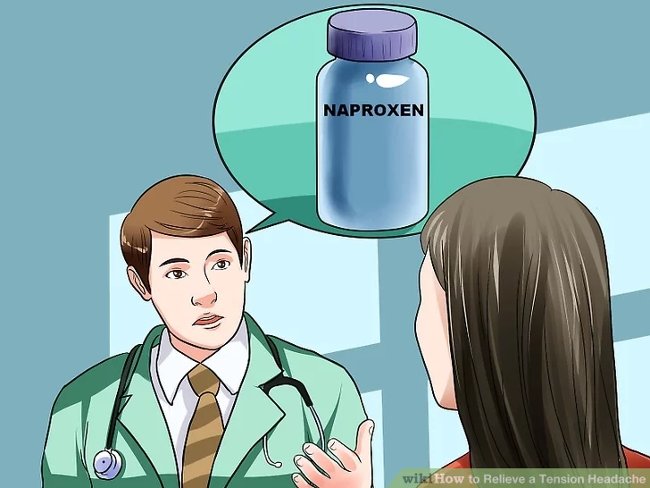
If you take over-the-counter pain relievers and lifestyle changes do not help relieve your tension headaches, your doctor may prescribe a stronger dose. These drugs include naproxen, indomethacin, and piroxicam.
- These prescription drugs can cause side effects such as bleeding, abdominal pain and an increased risk of cardiovascular diseases. Your doctor will tell you about side effects or complications before prescribing medication.
- If you have a chronic muscle tension headache and migraine, your doctor may prescribe a triptan to help with pain. The groups of opiates and narcotics are rarely prescribed due to side effects as well as the risk of addiction and drug dependence.
3. Try acupuncture therapy
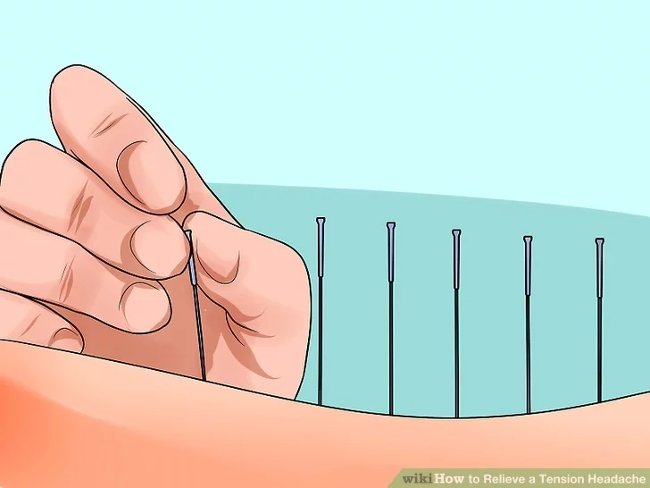
Acupuncture is a treatment that uses thin needles to pinpoint points on the body. These needles are stimulated manually or electrically, thereby enhancing blood circulation to surrounding areas , reducing stress or pressure. Studies show that acupuncture may be effective in reducing chronic muscle tension headaches.
- Acupuncture does not cause much pain or discomfort but must be done by an acupuncturist with a certificate. Acupuncture therapy has been shown to help relieve muscle tension headaches if done correctly.
- Dry needles are another form of treatment that includes acupuncture but not on traditional Chinese medicine principles such as acupuncture. This therapy uses needles to stimulate the body's stimulating points to relax muscles, reducing stress that causes muscle tension. This treatment can be done by trained health professionals such as therapists, massage specialists and doctors.
See also: 8 critical mistakes that most people make and how to solve them
4. Visit the spinal surgeon
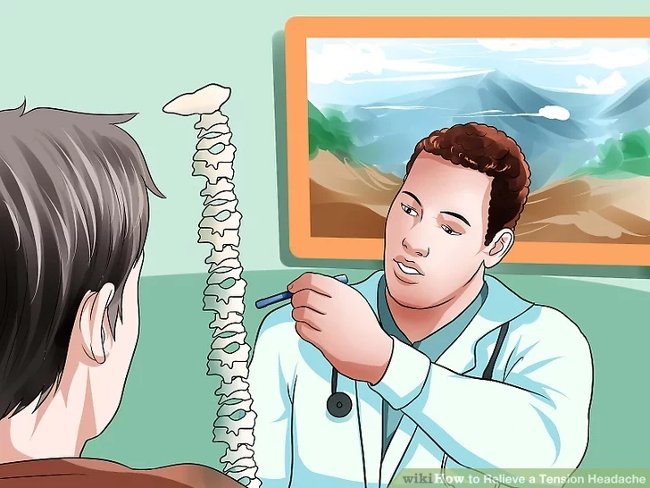
Recent studies show that chiropractic therapy performed by licensed professionals can treat muscle tension headaches, especially chronic pain.
- You can find a list of licensed chiropractic doctors' boards in many countries on the Federation of Chiropractic Physician's website to ensure the treatment is done by a specialist. Adjusted spine has been trained and has an operating license.
5. Ask your doctor about massage therapy
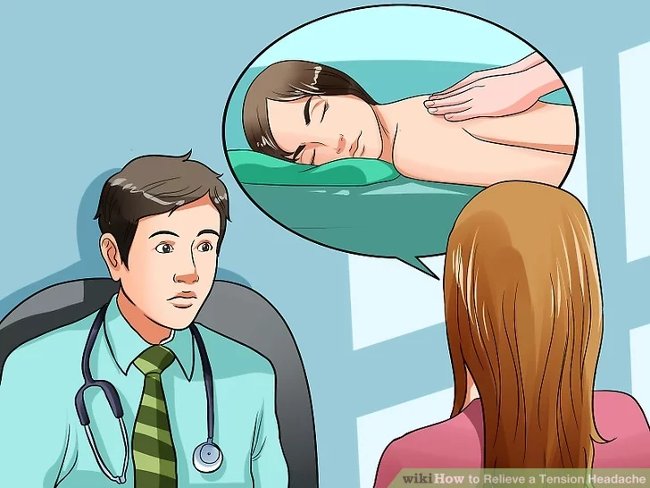
Medical massage is a bit different with massages just for relaxation. Massages that focus on the neck and shoulders are proven effective in treating muscle tension headaches and reducing the frequency of pain attacks. In addition, you can ask your doctor to introduce more about medical massage.
- Massage therapy may not be covered by health insurance. However, it is possible that you will still be paid if referred by your doctor. Ask the hospital to know if the insurance pays.
6. Take an eye exam
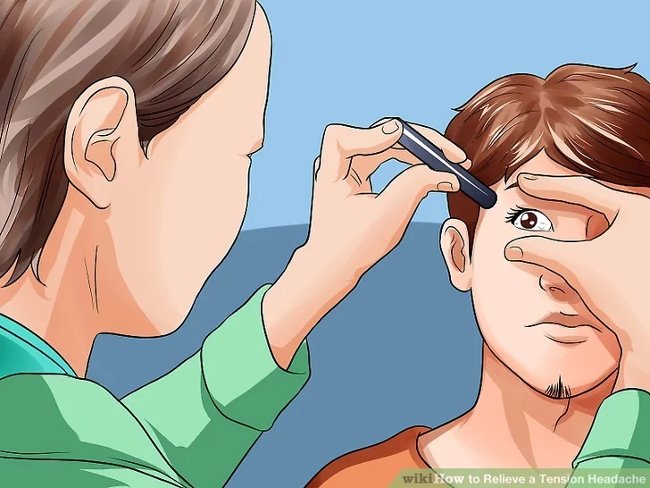
Eye strain is a common cause of muscle tension headaches. If you have frequent headaches ( twice a week ), you should arrange for an eye exam. Vision problems can contribute to headaches.
- If you're wearing glasses or using contact lenses, you should contact your eye doctor to check again. Visual acuity may change and the eyes will become strained if the type of glasses prescribed by the doctor you use is no longer appropriate.
Method 2: Use home remedies
1. Rest in a dark and quiet room
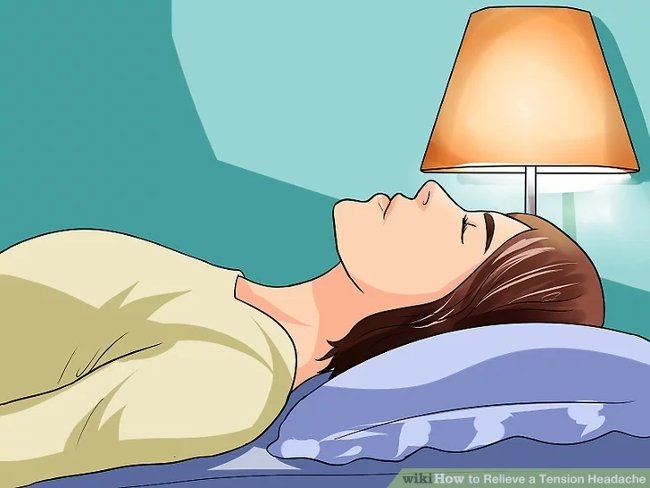
Stress is one of the major causes of headaches. When you have a headache, you may be sensitive to light and noise. To deal with this situation, you should sit or lie in a dimly lit room, close your eyes and try to relax your back, neck and shoulders.
- Turn off all sources that cause noises such as TV, computer or mobile phone.
- Close your eyes and put your palms in your eyes . Gently apply your palms to your eyes for about 2 minutes. This action will help the optic nerves to rest and the body to relax.
- Try doing exercises for your neck while in a dark and quiet room. Put your palms on your forehead. Use the muscles in your neck to gently press your forehead into your palm. Remember to keep your head upright when pressed.
2. Practice deep breathing
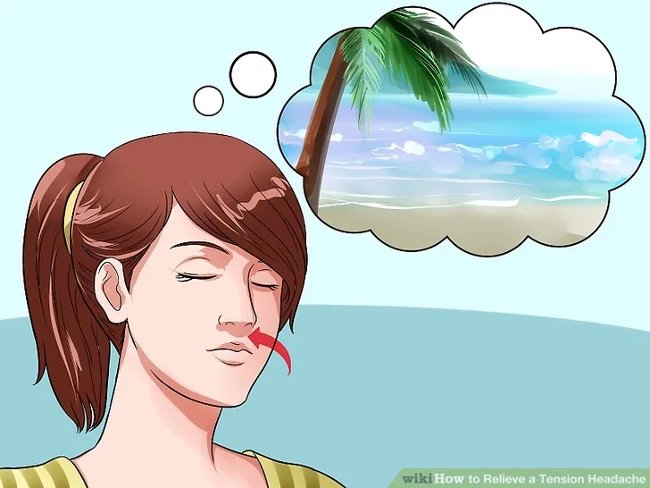
Deep breathing exercises help relax and relieve stress in the body, including the head. Breathe slowly and evenly, trying to relax.
- Close your eyes and take several deep breaths.
- Exhale slowly, relax the areas that feel stressed on your body. Imagine beautiful scenery like sandy beaches, sunny gardens or a country road.
- Bend your chin down to your chest. Slowly turn your head halfway from one side to the other.
- Take a deep breath and slowly exhale. Continue to imagine the beauty in the mind.
- Continue doing this exercise until you reach the state of relaxation.
3. Apply hot or cold gauze on the forehead
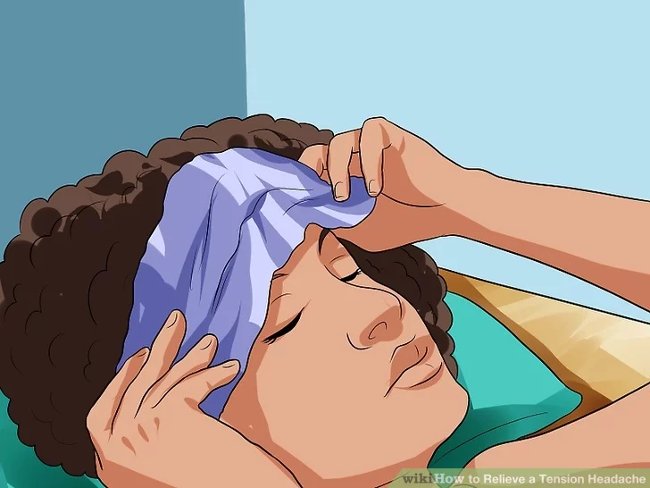
Hot and cold temperatures can help relieve pain and muscle tension in the head and neck.
- Apply a warm, moist towel or warm gauze to the nape or forehead. In addition, you can also take a hot shower under the shower for a long time, remember to let the water flow down the head or nape.
- Wrap an ice pack in a towel and apply it to the nape or forehead.
4. Rub peppermint oil into the temples, forehead and back of the jaw
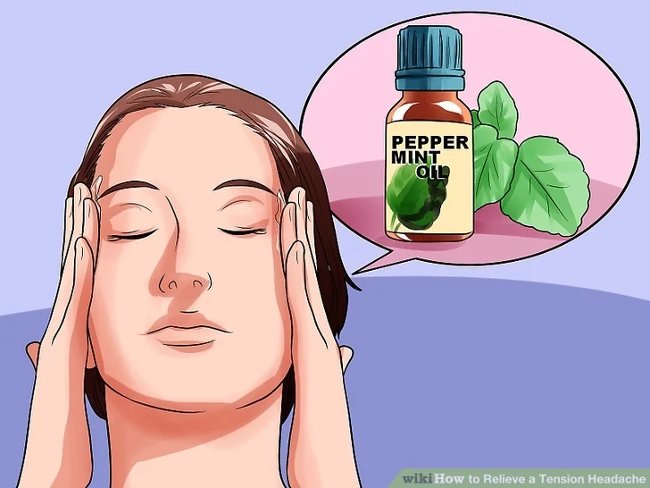
Peppermint oil works to soothe, relieve pain or reduce discomfort.
- When you apply a few drops of oil to your skin, you will feel cool on the oiled area. Take a deep breath and find a quiet place to sit or lie down.
- If skin is sensitive, you can dilute peppermint oil with 1-2 drops of olive oil or water before applying it to the skin.
5. Drink water or herbal tea
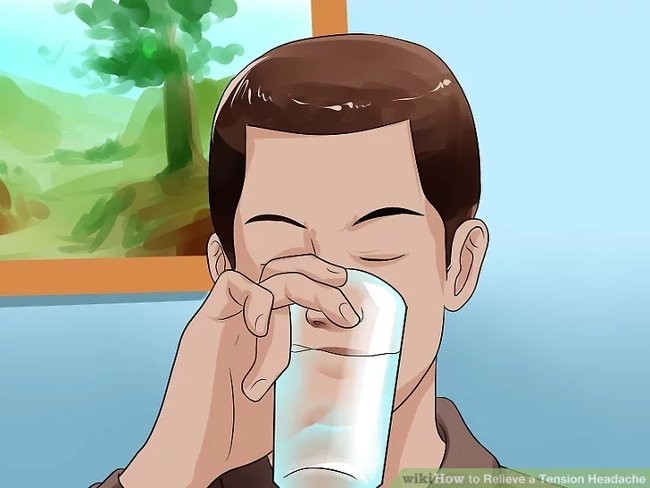
Drink water or herbal tea to supply water to the body. When you feel stressed, drink lots of water or make herbal tea to put your mind into a state of relaxation. Dehydration can cause headaches. Also, avoid drinks containing caffeine or alcohol, as these will only make you dehydrated.
6. Massage your face, head and hands
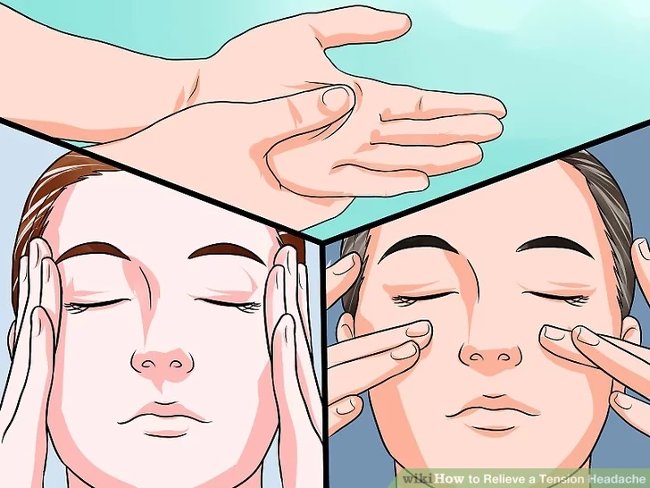
Massages focus on the upper body: face, head and hands. Use the back massage fingers and the sides of the head. Afterwards, gently massage the areas around the eyes. Use your fingertips to gently scratch your scalp, not moving your scalp more than 1cm. Continue, sweep your fingers along the other hand with your fingertips and rub your palms together.
7. Try using reflexology to relieve headache
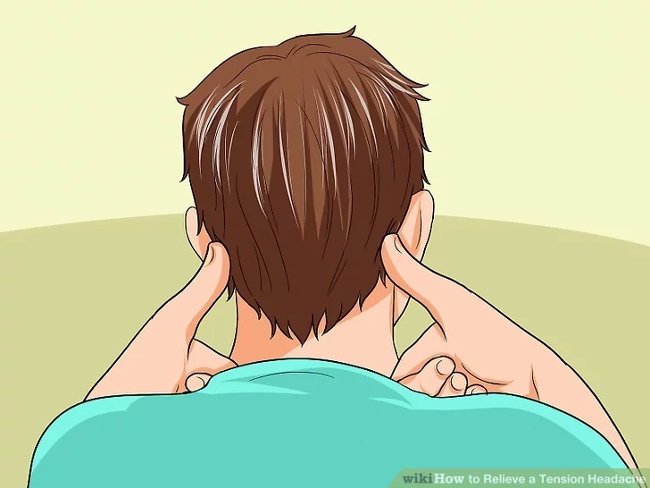
Headache reflexology is a simple acupressure technique that you can perform at home.
- Place two thumbs on either side of the skull.
- Identify the depressions on both sides of the head, where the head is adjacent to the neck. These positions are just outside the thick muscle mass running down the head, or about 5cm from the middle of the head.
- Press and thumb up and up until you feel relaxed.
- Continue to use two thumbs lightly to press and day with circular motions for 1-2 minutes.
Method 3: Adjust lifestyle
1. Exercise
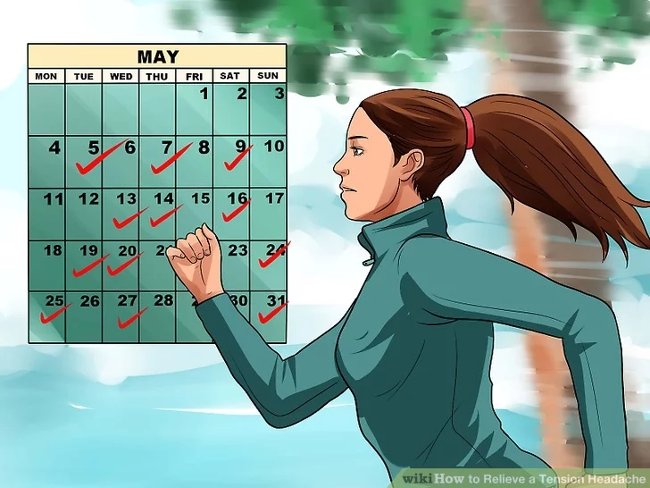
Physical activity can help relieve stress or tension inside the body, and release endorphins in the brain to help relieve pain. Spend 30 minutes walking, cycling or jogging at least three times a week. You need to be persistent with regular training schedules.
See also: 4 "anti-scientific" weight loss tips can make you fat
2. Stand in the mountain posture (mountain pose) to improve your posture
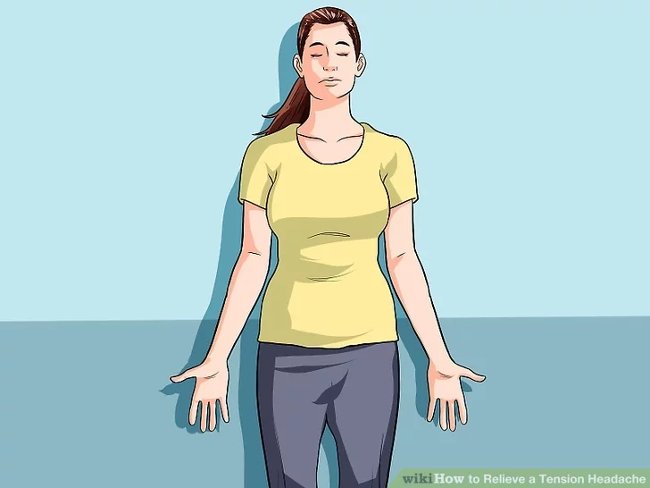
Correct posture can prevent muscles from stretching, while reducing pressure on the head. Yoga poses like mountain postures will help you improve your posture and relax.
- Stand with your feet wide apart.
- Two hands on both sides, two shoulders behind.
- Tummy tuck in, coccyx toward floor.
- Bend your chin down to your chest. Try to maintain this posture for at least 5-10 breaths.
3. Sitting in a stick pose (stick pose)
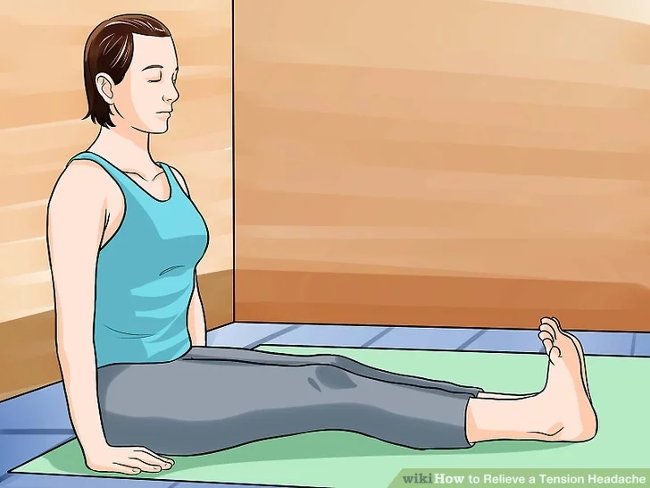
Stick posture is also a yoga posture to improve posture and perform deep breathing.
- Sit straight leg straight forward.
- Stretch your toes back, toward your body.
- Put your shoulders back and place your hands to the sides.
- Hold your belly, coccyx toward the floor. Bend your chin down to your chest. Try to hold this position for at least 5-10 times to breathe.
- In addition, you can also sit cross-legged if you see an uncomfortable leg stretch.
4. Avoid foods with MSG and caffeine
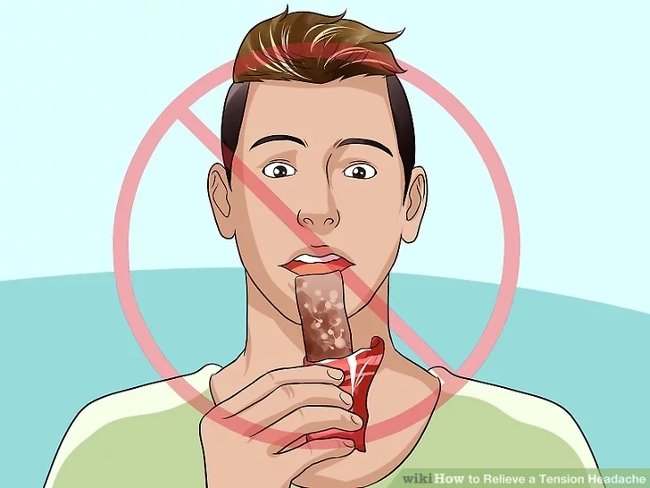
MSG , also known as main pasta, is a spice usually found in Chinese dishes. Some people react to MSG by a headache. However, there is no scientific evidence that shows the link between MSG and headaches. Other foods that can cause headaches include:
- Chocolate
- Cheese
- Tyramine acid amino acids in red wine, cheese, smoked fish, chicken liver, figs and some beans
- Types of nuts
- Peanut butter
- Some fruits like avocado, bananas and citrus fruits
- Onions
- Dairy products
- Meats contain nitrate such as bacon, sausage, salted meat
- Fermented or vinegar-soaked food
See also: Top 10 common mistakes when processing everyday dishes
5. Sleep at least 8 hours every night
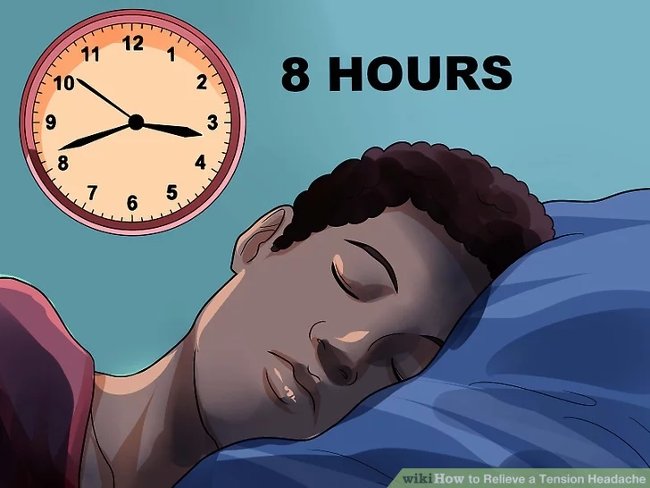
Regular sleep will help your brain and body not get stressed and anxious, two important factors that cause muscle tension.
Method 4: Prevent muscle tension headaches
1. Log your headaches
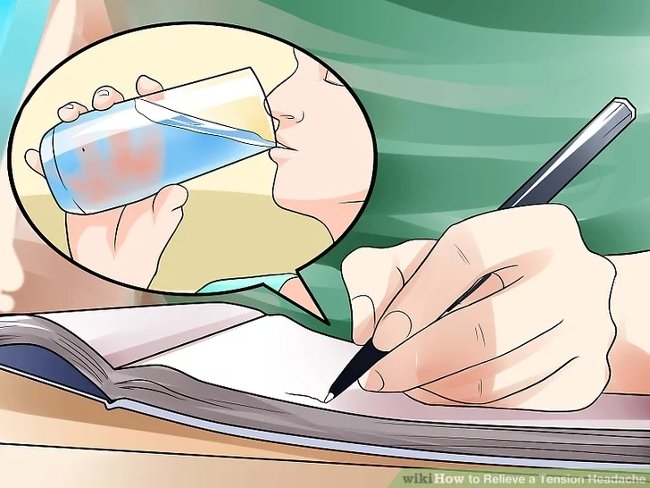
This will help you identify the source of headaches and how to adjust the environment, daily routines to avoid headaches.
When you begin to feel a headache, write down the date and time when the headache appears. Record the food and drinks you used a few hours ago, how many hours of sleep last night and what you are doing before a headache appears. Take notes about how long the headache lasts and how you can cure the headache.
2. Perform daily relaxation and stress control methods
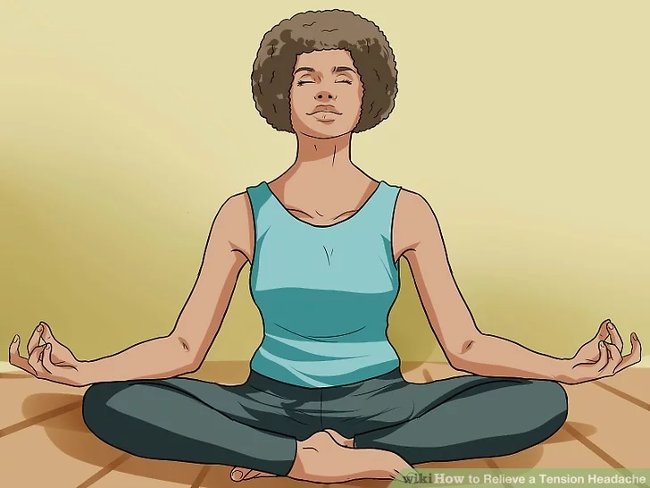
- You can take yoga classes in the morning, 15-20 minutes of meditation or practice deep breathing before going to bed.
- Practice at least 3 times / week to dispel stress and pressure.
3. Maintain a healthy lifestyle
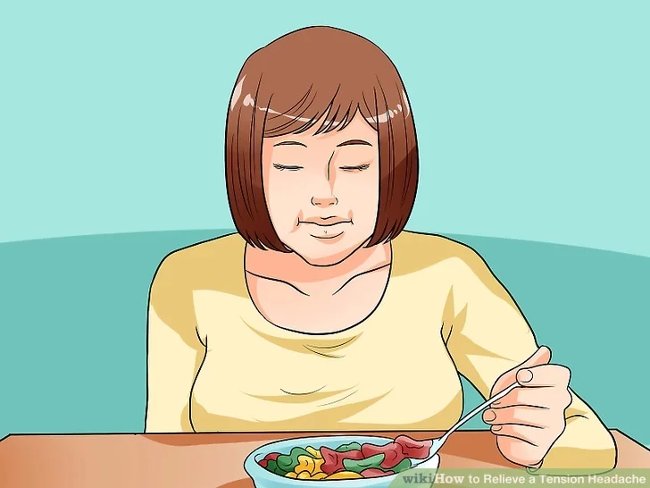
- Avoid caffeine, alcohol and tobacco.
- Sleep 8 hours a night and take care of yourself by avoiding stress at home and at work.
- Apply a balanced diet, avoid MSG or foods that contain substances that cause headaches.
- Drink plenty of water every day and maintain body water.
See also: 6 things to do to avoid the consequences of staying up late
4. Talk to your doctor about preventive medicines if you have chronic headaches
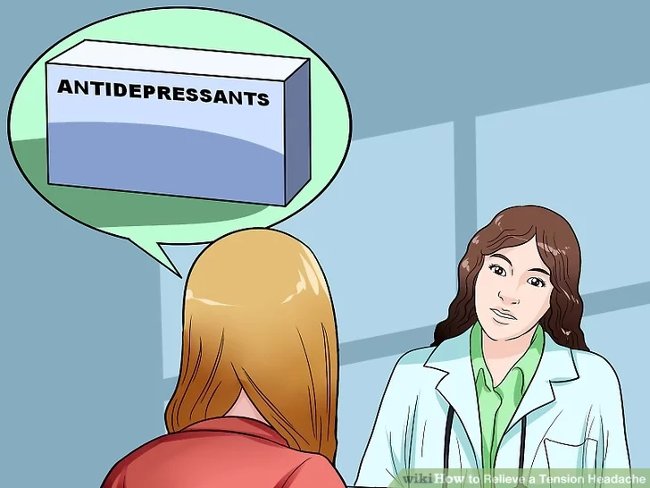
Your doctor will check to make sure you don't have a more serious migraine or disease. If the headache is not relieved despite the use of pain relievers and medications, your doctor may prescribe preventive medicine. These drugs include:
- Tricyclic antidepressants are most commonly used to prevent muscle tension headaches. Side effects of this group of drugs include weight gain, drowsiness and dry mouth.
- Anticonvulsants and muscle relaxants like topiramate. However, more research is needed to determine the effectiveness of anticonvulsants and muscle relaxants in preventing muscle tension headaches.
Note that preventive medicine may take weeks or more to accumulate in the body before it works. Therefore, you need to be patient and continue to take your prescribed dose, even if you do not see improvement after you start taking the medicine. Your doctor will monitor your health to know the effectiveness of preventive treatment.
See also: If your body has these 12 signs, you are eating too much sugar!
Having fun!
You should read it
- 10 ways of eye muscle training and vision enhancement are not to be missed
- You want an 8-zone body? No need to go to the practice room!
- 8 back pain relief exercises you can do right at your desk
- Apps that help you smash stress and anxiety
- 15 basic errors when exercising can be harmful to your health
- 16 great benefits from lemon you may not know yet
- A simple, effective, full body massage guide at home
- The first aid steps in time when the hand jammed into the door gap
May be interested
- How to chase mosquitoes to prevent dengue, Zika virus
 hot and humid weather is an opportunity for mosquitoes to grow, especially in the context of the world being afraid of zika virus. what secrets do you have to prevent mosquitoes for each family member, especially for young children?
hot and humid weather is an opportunity for mosquitoes to grow, especially in the context of the world being afraid of zika virus. what secrets do you have to prevent mosquitoes for each family member, especially for young children? - 6 secret techniques that help you get enough sleep in just a few hours
 on average, each of us usually spends 28.3 years sleeping, about a third of our life and that time is not small. so how many hours should we sleep every day?
on average, each of us usually spends 28.3 years sleeping, about a third of our life and that time is not small. so how many hours should we sleep every day? - The syndrome of 'dead butt', the nightmare of many people sitting
 anyone who has been sitting for hours in a chair has experienced a feeling of numbness in one or both sides. this feeling will disappear in the process of movement so many people think that it is not a big problem without knowing that it is a premise for a more serious syndrome called death butt syndrome.
anyone who has been sitting for hours in a chair has experienced a feeling of numbness in one or both sides. this feeling will disappear in the process of movement so many people think that it is not a big problem without knowing that it is a premise for a more serious syndrome called death butt syndrome. - Unexpected discovery: Physical and breathing surveys are the best way to diagnose asthma
 researchers at the university of texas have found that identifying and treating asthma is effective thanks to physical, respiratory and health history tests.
researchers at the university of texas have found that identifying and treating asthma is effective thanks to physical, respiratory and health history tests. - Depression affects the male and female brains in many different ways
 a recent study from cambridge university has found depression affects the brains of men and women in many different ways, thereby promising to find appropriate target treatments.
a recent study from cambridge university has found depression affects the brains of men and women in many different ways, thereby promising to find appropriate target treatments. - 5 eating habits should be avoided to avoid type 2 diabetes
 let us refer to 5 eating habits to avoid getting type 2 diabetes in the following article!
let us refer to 5 eating habits to avoid getting type 2 diabetes in the following article!






 12 ways to treat headaches immediately without using drugs
12 ways to treat headaches immediately without using drugs 7 simple ways to eliminate headaches without taking medicine
7 simple ways to eliminate headaches without taking medicine The 'unique' lifestyle and the terrifying 'strange' healing method of the ancient Greeks
The 'unique' lifestyle and the terrifying 'strange' healing method of the ancient Greeks 8 causes of headaches in the morning
8 causes of headaches in the morning Why does deep breathing help relieve stress quickly?
Why does deep breathing help relieve stress quickly?